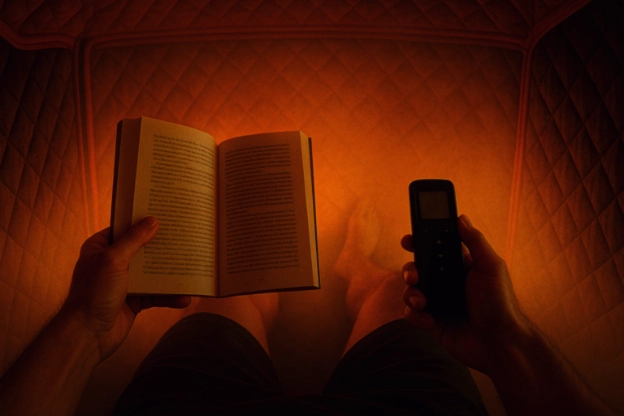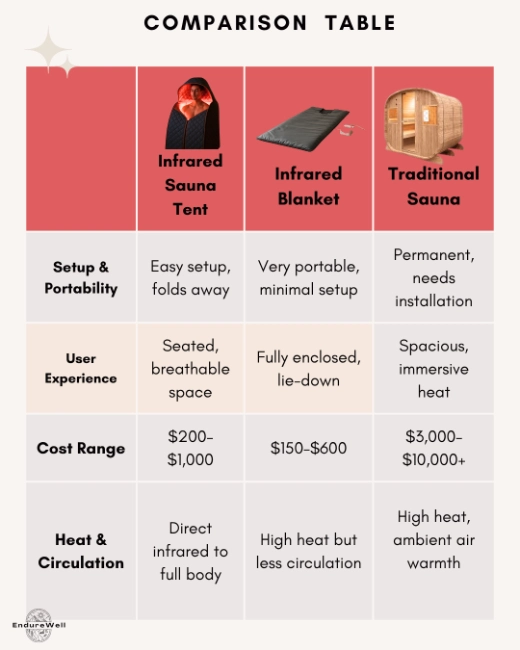Infrared Sauna Tent Benefits you never expected

Let’s be honest. Sometimes it can feel like the wellness world is crowded with gear after gear that promise better sleep, faster recovery, more energy ... .the list keeps getting bigger. But somewhere between the cold plunges, wearable trackers, and red light panels, infrared sauna tents have somehow quietly built a loyal following. And not just because they look like something out of a sci-fi recovery pod.
People aren’t buying these tents as a gimmick as one may sometimes imagine. They’re buying them because they actually want to feel better, and for many, they do.
In this article, we’re breaking down the real infrared sauna tent benefits, what the science says, what users are actually reporting. Are these compact heat therapy tools worth making space for in your routine (and your home)?
Let’s find out.
Do Infrared Sauna Tents Actually Work?
Many people (including myself) can be skeptical when they first hear about a foldable infrared tent that plugs into a wall and promises “detox,” “relaxation,” and “pain relief.” But users, ranging from hardcore athletes to even stressed-out parents show surprisingly unified opinions in their feedback. Comments such as:
💡 Real User Experiences:
“I sweat a ton and slept like a baby. 10/10 would recommend saunas for anyone looking to detox.”
“My skin feels great, my body feels limber, my aches and pains are lessened, and I am relaxed.”
“It gets hot. It makes you sweat. It sets up quickly and breaks down for storage just as easily.”
These are real, unfiltered testimonials you'll typically see on shopping portals when looking at these devices. They tell a clear story: these things do something. Are they as intense or comprehensive as a built-in $8,000 Clear Light sauna? Probably not. But as some users would put it: “Is it better than not having a sauna? Absolutely.”
Infrared heat doesn’t warm the air around you like traditional saunas. It heats your body directly using far-infrared light, which penetrates deeper into your tissues. That’s why people can still sweat buckets and benefit from infrared sauna detoxification… even if the ambient temperature inside the tent doesn’t hit traditional sauna highs.
Real Benefits of Infrared Sauna Tents (What Science and Experience Say)
When it comes to infrared sauna tent benefits, real-world use lines up surprisingly well with published research. Here’s what both science and consistent users are reporting:
Pain Relief That’s More Than Psychological
Many people (including myself), especially those with chronic back or joint pain, describe real lasting relief after consistent sauna tent use. We did some digging and even found one particular user recovering from an accident. After three years of pain management they said, “I haven’t felt this good in years.”
The research supports this too. A pilot study on infrared sauna therapy for rheumatoid arthritis found statistically significant drops in both pain and stiffness, without worsening symptoms.
Detox & Circulation Support
The heat from infrared tents promotes vasodilation. That’s your blood vessels expand, improving circulation and helping flush out metabolic waste. It's even sometimes described as a “lymphatic flush” that supports a healthy immune system and can even lead to visibly improved skin tone. It’s not uncommon to see a ‘glow’ and softer skin after regular sessions.
Infrared sessions have also been shown to improve endothelial function (aka how well your blood vessels respond and dilate). This is a key marker of cardiovascular health according to a review on Far-infrared saunas for treatment of cardiovascular risk factors, published in Canadian Family Physician.
Improved Sleep & Stress Reduction
Another consistent theme with sauna tents revolves around better sleep. This is especially true when used in the evening. One reason for this is that sauna sessions have been linked to increased melatonin and dopamine release, both of which play a role in relaxation and circadian regulation.
I personally would describe this calming after glow post-session feeling as if you're in a slightly euphoric state. I have also noticed that I fall asleep faster and stay asleep longer. A second hand effect of all this is improved hormonal health. All this ties in together with my success in using Red light therapy for Testosterone benefits and overall recovery.
Clearer, Healthier Skin
One of the more underrated infrared sauna tent benefits is its effect on your skin. Users often describe brighter skin tone, fewer breakouts, and even better texture over time. The reason? Heat stimulates cell turnover and increases blood flow to the skin’s surface. This is a combination that can support both detox and nutrient delivery.
Are Portable Infrared Saunas Worth It? (Cost, Convenience & Safety)
Here’s the deal: traditional saunas are amazing. But for most people, owning one can be expensive. It can also be space-intensive and unrealistic to install. Infrared sauna tents hit a sweet spot. They are accessible, compact, and effective.
Affordability That Doesn’t Cut Corners
A high-end sauna setup can easily run you $5,000-$10,000+. Infrared tents? You can get a solid unit for under $500. That’s a game-changer if you’re experimenting with new tools but not ready to commit to a full build.
Set Up in Minutes, Not Hours
Most tents can be assembled in under 10 minutes. They plug into a standard outlet and fold away easily when you’re done. In some situations you can even sauna while watching TV or reading. This makes infrared sauna tents the most low-effort high-impact tools in the wellness space.
What About Safety?
There are a few valid concerns. The biggest is EMF exposure, though many newer models are designed to be low-EMF. Material quality also matters… Ones made from cheap plastic can give off gas, especially under high heat. And of course, like almost all saunas, hydration and heat management are a must. Concerns about Infrared Sauna Dangers are valid and should not be ignored.
Who Should (and Shouldn’t) Use One?
You’ll Likely Benefit If You Are:
An athlete or very active person: You're likely looking to recover faster between workouts, reduce soreness, and minimize injury risk? Heat therapy has been shown to help improve circulation and flush lactic acid, speeding up recovery.
An extreme optimizer / biohacker: You probably want measurable tools for relaxation, detox, and sleep optimization? Tents can be paired with wearables and HRV tracking for more insights.
A busy professional: Always overworked and overstimulated? Infrared sauna tents are a low-effort, high-return option to help you downregulate your nervous system before bed.
Longevity seekers: Focused on prevention and aging gracefully? Regular heat exposure has been associated with reduced all-cause mortality, better cardiovascular function, and improved insulin sensitivity.
Curious how these stack up with other recovery tech? See Are Compression Boots Worth It for a complementary approach.
You Should Avoid If:
You’re pregnant or breastfeeding.
You have unmanaged cardiovascular conditions, acute illnesses, or are taking medications that interfere with thermoregulation.
You’re currently dehydrated or electrolyte-depleted.
You’re using substances like alcohol or sedatives before a session.
As always, when in doubt, always talk to a doctor.
Conclusion: Are Infrared Sauna Tents Worth It?
If you’re expecting a single infrared sauna tent to melt fat, fix chronic illness, and glow up your skin in a week… You may need to look elsewhere.. If you’re looking for a practical, science-backed, recovery-supporting, stress-reducing tool that actually fits into your life, then yes, you may be on the right path with these.
Infrared sauna tents can sometimes seem like a ‘nice to have’....but they're better than-nothing. Having them as an option is actually pretty great, especially when used consistently. They’re accessible, low-risk, and for many people… they just work.
If you’re convinced but still curious about the timeline to expect results, we cover that in How Long to See Benefits of Infrared Sauna.
Frequently Asked Questions
Do infrared sauna tents actually help with detox?
Yes. Infrared heat promotes sweating, boosts circulation, and supports your lymphatic system. All of which are key to eliminating toxins. Dive deeper into the science in our guide to infrared sauna detoxification.
How long should you stay in an infrared sauna tent?
Most users benefit from 20-30 minute sessions. This also depends on your ability to tolerate heat and your hydration levels. Beginners should start on the lower end and gradually build up.
Are they safe to use every day?
Generally, yes. Just stay hydrated, avoid using when sick or under the influence, and opt for low-EMF models. If you have any underlying conditions, consult your physician.
Is there a difference between sauna tents and sauna blankets?
Absolutely. Sauna tents let you sit upright with more air circulation and space, while blankets are more restrictive. They heat you while lying down. For a full comparison, check out infrared sauna blanket vs sauna.
Keep Exploring
If you found this helpful, here are more ways to level up your recovery and wellness stack:
Is pulsed electromagnetic field therapy legit or just pseudoscience with good branding?
Red light for better skin sounds great…but does it actually fade fine lines, improve tone, or fight acne? Here's what the research (and real users) say.
Can a $200 massage gun really help with recovery, or is it just temporary hype and great marketing?
This article is for informational purposes only and is not intended to provide medical advice. Always consult your qualified healthcare professional before beginning any new health, wellness or recovery regimen.



